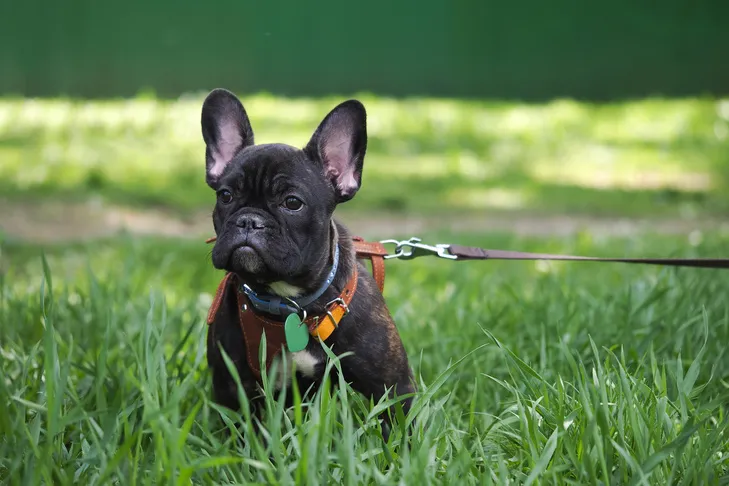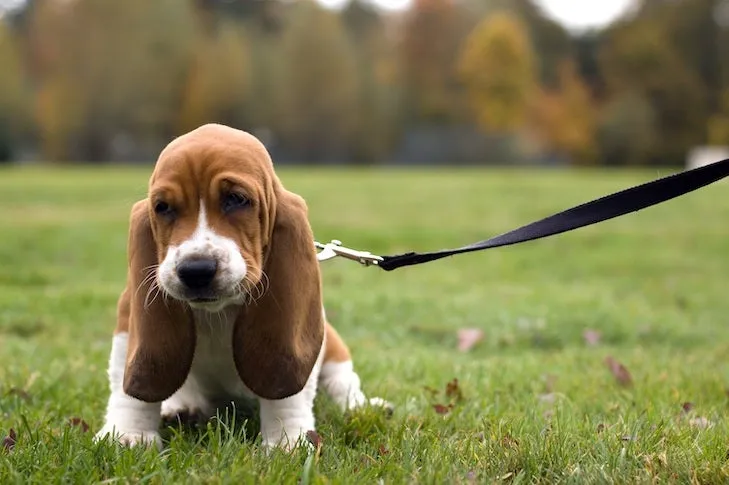Many new puppy owners wonder, “When Do Puppies Walk On A Leash?” The truth is, while it might seem like a natural dog behavior, walking politely on a leash is a skill that needs to be carefully taught. The ideal time to start this training is often when your puppy is young, typically around 8-10 weeks old, once they’ve settled into their new home and had their first set of vaccinations. Early introduction to the collar, harness, and leash in a positive manner sets a strong foundation for future enjoyable walks. This guide, drawing on expert advice, will walk you through the essential steps to teach your puppy to walk confidently and happily by your side. how to get your puppy to like the leash from the very beginning, ensuring a positive experience.
When to Start Leash Training Your Puppy
While 8-10 weeks is a general guideline for introducing leash concepts, the precise timing for when puppies walk on a leash can vary. The most crucial factor is your puppy’s individual comfort level and their vaccination status, ensuring they are safe to explore the outdoors. Starting early allows puppies to associate the leash with positive experiences, preventing potential fear or resistance later on. Focus on short, fun sessions that build confidence rather than forcing them into long walks too soon. This early exposure, even just around the house, is vital for proper socialization and skill development.
Foundational Steps for Leash Training Success
Building a solid foundation is key to teaching your puppy excellent leash manners. Dog training expert and AKC Family Dog training and behavior columnist Kathy Santo emphasizes a stepwise approach to make this a positive experience for both you and your puppy. Patience and consistency are your best tools during this learning phase, transforming what can be a challenge into a rewarding bond-building activity.
Introducing the Collar or Harness and Leash
Begin by familiarizing your puppy with wearing a collar or a harness and a leash. Allow them to wear these items for very short periods inside the house. During this time, engage them in playful activities and offer tasty treats. The goal is for your puppy to associate their collar and leash with fun and delicious rewards, creating a positive emotional response to these new sensations. This initial conditioning helps prevent any negative associations that might make future training more difficult.
Teaching a Positive Sound Cue
Next, introduce a consistent sound cue that signifies “food is coming.” Many trainers use a clicker, while others prefer a verbal cue like “yes” or a simple tongue cluck. Whichever you choose, the method remains the same: in a quiet, distraction-free environment, with your puppy wearing their collar and leash, make your chosen sound. The instant your puppy acknowledges or looks at you, immediately reward them with a treat. With repetition, your puppy will quickly learn that the sound means good things are headed their way, encouraging them to focus on you.
Encouraging Your Puppy to Come to You
Once your puppy understands the sound cue, encourage them to move towards you. While they are still wearing the leash and collar, back up a few steps after making your cue sound. When they reach you, reward them generously. Gradually increase the distance, always rewarding them when they successfully come to you. Continue this progression until your puppy reliably comes to you and walks a few paces by your side after hearing the cue. Remember that puppies have limited attention spans, so keep training sessions brief and enjoyable, always ending on a high note before they become tired or bored.
 French bulldog puppy in a harness sitting in tall green grass on a leash for a walk.
French bulldog puppy in a harness sitting in tall green grass on a leash for a walk.
Practicing Indoors
With your puppy now understanding how to come to you, it’s time to practice short walks inside a room with minimal distractions. The sensation of the leash around them, even without external stimuli, provides enough of a challenge at this stage. Continue to offer praise and treats as your puppy learns to walk alongside you on the leash. These indoor sessions build confidence and muscle memory in a controlled environment, preparing them for the greater challenges of the outside world without overwhelming them.
Venturing Outdoors
Finally, your puppy is ready to test their new skills in the great outdoors. This step introduces a new level of complexity due to the myriad of sounds, smells, and sights that will naturally intrigue your puppy. Be patient and keep these first outdoor walks very short. During the walk, stay observant. If your puppy appears poised to lunge towards something or becomes distracted – you’ll notice this by keeping a close eye on their body language – make your cue sound and take a few steps away. Reward them with a treat for refocusing on you and following your lead. how to train a puppy not to pull is a crucial skill to develop early on for pleasant walks.
 Basset Hound puppy sitting in the grass on lead.
Basset Hound puppy sitting in the grass on lead.
Troubleshooting Common Leash Training Challenges
Even with the best foundation, you might encounter issues as your puppy grows, explores new places, and faces new distractions. Teaching loose-leash walking is not only more pleasant for both of you but also prepares your dog for Canine Good Citizen tests. Here are some tips, courtesy of the AKC GoodDog! Helpline, for common leash training difficulties.
Addressing Puppy Pulling
If your puppy begins to pull in the opposite direction, immediately stop moving and become “a tree.” Stand completely still and refuse to budge until your dog returns to you or the leash slackens. Avoid yanking or jerking the leash, or dragging your dog along. Consistent refusal to move when pulling occurs teaches them that pulling gets them nowhere. For persistent pullers, tools like front-hook harnesses or head halters can be effective alternative training aids, providing better control and discouraging the behavior. For more in-depth solutions, consider learning how to stop a dog from pulling while walking.
Managing Lunging Behavior
If your dog targets something specific during a walk—another dog, a car, or a skateboarder—it’s essential to be proactive. Anticipate their reaction and try to redirect their attention with a treat before they have a chance to lunge. Increase the physical distance between your dog and the perceived trigger. Stay vigilant and be ready to intervene before the source of their frustration or excitement gets too close. While this behavior might be more common in certain breeds like herding dogs, any dog can be startled or overstimulated by unfamiliar or exciting elements in their environment.
Handling Excessive Barking on Walks
Some dogs develop a habit of barking at other dogs or passersby while on a walk. Often, this behavior can stem from insufficient physical or mental stimulation. Ensure your dog receives an appropriate amount of exercise and enrichment for their age and breed. If the barking persists, employ a similar strategy as with lunging: create distance from the trigger and offer treats before they start barking. Over time, they will associate seeing other dogs with receiving a treat and learn to turn their attention back to you, gradually reducing the barking response.
Successful leash training is an ongoing process that requires patience, consistency, and positive reinforcement. Gradually, you’ll find yourself needing fewer treats and doing less troubleshooting during walks. However, it’s always a good idea to keep some treats on hand for random positive reinforcement of good leash-walking behavior. Enjoy the many walks ahead with your well-behaved companion!
